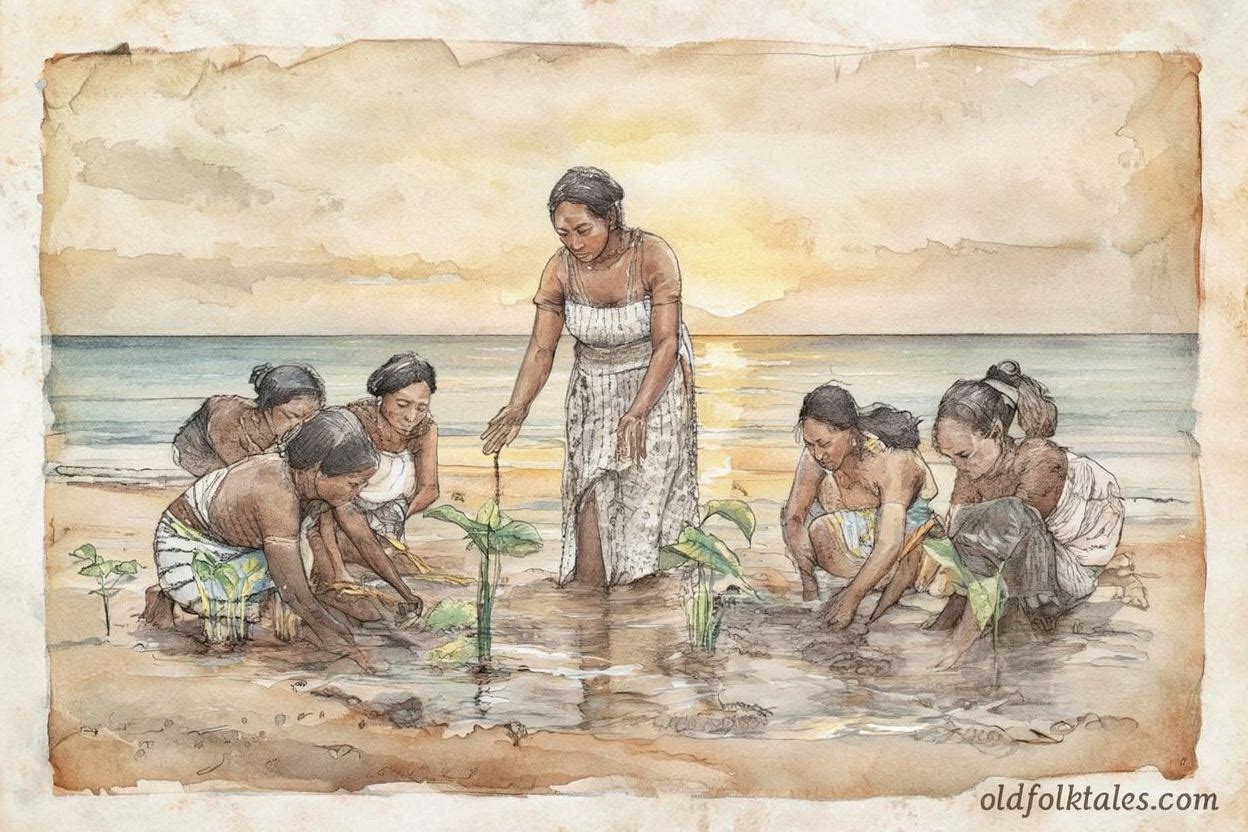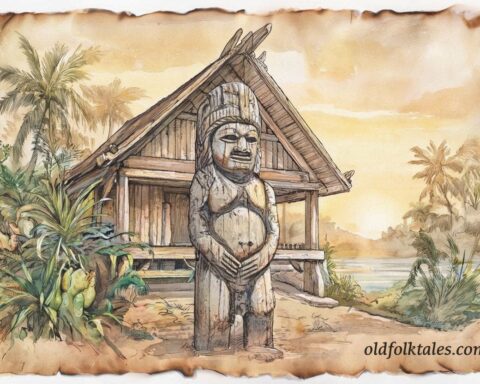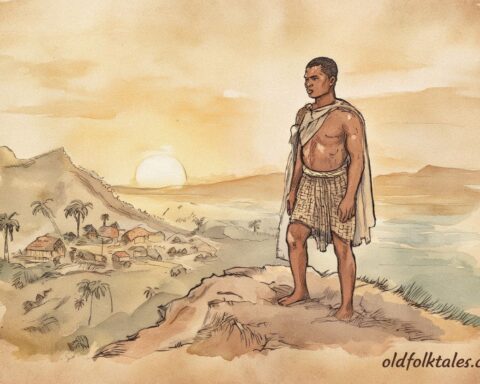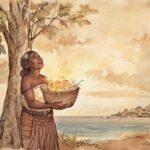Long ago, when the islands of Palau were still new and the people depended only on what they could gather from the wild, a goddess descended from the heavens. Her name was Dirachedesbsungel, though many came to know her as Meduu Ribtal, the Lady of Breadfruit. She appeared from the mist that rose above the ocean, her hair like flowing vines and her skin glowing with the green of new leaves. Wherever she stepped, flowers opened and streams began to flow.
In those early days, life was hard. The people hunted fish and gathered roots, but the land gave little, and storms often washed away what they found. The women, especially, carried the burden of feeding their families. When Meduu Ribtal saw their struggle, compassion filled her heart. She decided to teach them the sacred art of growing food from the earth so that their children would never go hungry again.
She gathered the women of the villages and spoke to them beneath the shade of a great banyan tree. Her voice was gentle yet powerful like the wind before rain. “From the hands of women,” she said, “life shall grow. The land will answer to care and patience. In return, it will feed all who live in harmony with it.”
She showed them how to soften the soil with sticks and shells, how to plant the young taro in the low wetlands where water could embrace its roots, and how to weave mats from palm leaves to protect the crops from the heat. She then led them into the forest and pointed to a tall tree with round, green fruit. “This is the tree of plenty,” she said. “Its fruit will fill your stomachs, its leaves will shade you, and its wood will build your homes.”
The women listened carefully as she taught them when to plant and when to harvest, how to read the patterns of the stars and the rhythm of the rain. She taught them to give thanks before taking from the earth, for gratitude was the key to abundance.
Soon, the women’s gardens began to flourish. The first taro leaves grew wide and green, and the breadfruit trees bent under the weight of their harvest. The men, amazed by the bounty, built larger homes and canoes, for the people were strong and joyful once more.
Meduu Ribtal visited each village, watching with pride as the people thrived. But she also knew that her time on earth was not meant to last forever. One evening, as the crimson sun melted into the sea, she called the women to her side. “The gifts I have given you will live on,” she said. “But soon I must return to the spirit realm beneath the waters. When you eat the breadfruit or taste the taro, remember me, for I am part of the earth that feeds you.”
The women wept, for they loved her dearly. Meduu Ribtal comforted them and promised that her spirit would remain near. She walked to the shore, and with each step, the sea glowed softly beneath her feet. As the waves rose, her form shimmered and faded until she was gone, leaving only ripples that sparkled like stars.
The next morning, the fishermen saw something strange beneath the water. An island had formed below the surface, covered in coral and glowing sea plants. It was said that this was where Meduu Ribtal had gone to rest, her body becoming part of the ocean floor and her spirit nourishing the life above.
From that day forward, the Palauan people honored her with offerings of fruit and song. The women passed her teachings to their daughters, who learned to care for the land with patience and devotion. Each season when the breadfruit ripened, the people gathered to celebrate, giving thanks to Meduu Ribtal for her eternal gift.
Even now, when the sea is calm and the air is filled with the scent of ripe fruit, the elders say that her spirit stirs beneath the waves. The glowing coral is her hair, and the soft current that touches the shore is her breath. She remains the guardian of life, reminding her people that all abundance comes from love, respect, and the harmony between humans and nature.
Moral Lesson
The Breadfruit Story teaches that wisdom, patience, and gratitude sustain both people and the earth. Through respect for nature and the passing of knowledge, generations remain connected to their ancestors and to the land that gives them life.
Knowledge Check
1. Who was Meduu Ribtal in the story?
Meduu Ribtal was a goddess who taught the people of Palau how to cultivate taro and breadfruit.
2. What gifts did Meduu Ribtal give to the women of Palau?
She taught them how to plant, care for, and harvest crops, ensuring food and abundance for their families.
3. What did the breadfruit tree symbolize in the story?
It symbolized plenty, nourishment, and the balance between human care and nature’s generosity.
4. Where did Meduu Ribtal go after her time on earth ended?
She descended beneath the sea and transformed into an underwater island.
5. How do the people of Palau honor Meduu Ribtal today?
They remember her through offerings, songs, and seasonal harvest celebrations.
6. What is the main lesson of The Breadfruit Story?
That respect for the land and gratitude for nature’s gifts bring lasting harmony and abundance.
Source: Adapted from The Palauan Legend of Meduu Ribtal (The Breadfruit Story) in Palauan Oral Traditions and Legends Collection by the Palau Bureau of Arts and Culture (2013).
Cultural Origin: Palauan (Palau, Micronesia)











